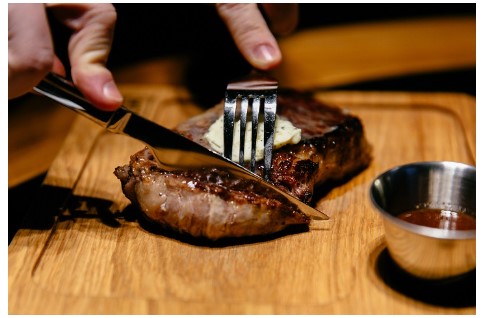
There’s nothing quite like sinking your teeth into a perfectly cooked ribeye steak. Known for its rich marbling and robust flavor, the ribeye is a cut of beef that promises an unforgettable dining experience. At Rosebud Steakhouse, we’re passionate about delivering the finest ribeye steaks to our guests. This blog post delves into the secrets behind achieving a juicy, flavorful ribeye steak, whether you’re grilling at home or dining out. From selecting the right cut to mastering the cooking techniques, we’ve got all the tips and tricks to ensure your ribeye steak is nothing short of perfection.
Understanding Ribeye Steaks
The ribeye steak, also known as the rib eye or rib steak, is a cut of beef that comes from the rib section of the cow. It’s renowned for its rich marbling, which contributes to its tenderness and flavor. The marbling refers to the streaks of fat within the meat, which melts during cooking and keeps the steak juicy. Understanding these characteristics can help you appreciate why ribeye is a favorite among steak lovers.
Choosing the Right Cut
Selecting the perfect ribeye steak is crucial for achieving that juicy, flavorful result. Look for a cut with ample marbling and a deep red color. At Rosebud Steakhouse, we source our ribeye steaks from Linz Heritage Angus Beef, ensuring high quality and superior taste. Consider bone-in ribeye for added flavor, or opt for boneless if you prefer a more uniform cook. Quality cuts make all the difference in the final product.
The Importance of Aging
Aging is a key process in developing the flavor and tenderness of ribeye steaks. There are two main types of aging: dry aging and wet aging. Dry aging involves hanging the meat in a controlled, chilled environment for several weeks, intensifying its flavor and tenderness. Wet aging, on the other hand, occurs in vacuum-sealed bags and is generally quicker. Both methods enhance the ribeye’s texture and taste, but dry aging is often preferred for its complex flavor profile.
Preparing Your Ribeye Steak
Proper preparation is essential for achieving a juicy ribeye steak. Start by letting the steak come to room temperature before cooking. This ensures even cooking and helps the steak cook more evenly. Season generously with salt and pepper, or use your favorite steak rub. Avoid over-marinating, as it can overpower the natural flavor of the ribeye. Simple seasoning allows the quality of the meat to shine through.
Cooking Techniques for Juiciness
Grilling, pan-searing, and broiling are popular methods for cooking ribeye steaks. Each technique can yield a juicy result if done correctly. For grilling, preheat your grill to high heat, sear the steak for a few minutes on each side, then move it to indirect heat to finish cooking. Pan-searing involves cooking the steak in a hot, oiled pan, followed by finishing in the oven if needed. Broiling is similar to grilling but done in an oven. Each method requires careful attention to time and temperature.
Achieving the Perfect Sear
A good sear is crucial for a juicy ribeye steak. The Maillard reaction, which occurs when the steak’s surface reaches high temperatures, creates a flavorful crust. Ensure your cooking surface is hot before adding the steak, and avoid moving it around too much. Let the steak sear undisturbed for a few minutes on each side. This caramelization process enhances the steak’s texture and flavor.
Resting the Steak
Resting is a crucial step often overlooked. After cooking, allow the ribeye steak to rest for about 5-10 minutes before slicing. This resting period allows the juices, which move to the center of the steak during cooking, to redistribute throughout the meat. As a result, the steak will be juicier and more flavorful when cut. Cover the steak loosely with foil to keep it warm while resting.
Serving Suggestions
Ribeye steaks are incredibly versatile and pair well with a variety of sides and sauces. Classic accompaniments include creamy mashed potatoes, grilled vegetables, or a fresh salad. For a decadent touch, serve with a rich mushroom sauce or a dollop of herb butter. Whether you prefer simple sides or elaborate dishes, ribeye steaks can be the centerpiece of a memorable meal.
Common Mistakes to Avoid
Avoiding common mistakes can make a big difference in your ribeye steak’s quality. Overcooking is a frequent issue; use a meat thermometer to ensure you reach your desired doneness. Don’t skip the resting period, as it affects juiciness. Also, avoid using a fork to flip the steak, as piercing it can release valuable juices. Proper technique and attention to detail are key to a perfect ribeye.
Tips for Perfecting Your Ribeye Steak
Perfecting your ribeye steak involves a combination of quality ingredients, proper techniques, and a bit of practice. Invest in a good meat thermometer, experiment with different seasonings, and practice your cooking methods. Every cook has their preferences, so don’t be afraid to adjust based on what works best for you. With time and patience, you’ll master the art of cooking juicy ribeye steaks.
Frequently Asked Questions(FAQs)
- What is the best way to cook a ribeye steak at home?
Grilling or pan-searing are the best methods. Preheat your grill or pan, sear the steak on high heat, then cook to your preferred doneness.
- How can I ensure my ribeye steak stays juicy?
Use proper cooking techniques, avoid overcooking, and let the steak rest before cutting to retain juices.
- Should I marinate my ribeye steak?
While ribeye steaks are flavorful on their own, you can use a simple seasoning or marinade to enhance taste without overpowering the meat.
- What is the difference between dry-aged and wet-aged ribeye steaks?
Dry-aged steaks have a more intense flavor and tender texture due to aging in a controlled environment, while wet-aged steaks are tender but with a milder taste.
- How do I know when my ribeye steak is cooked to the right temperature?
Use a meat thermometer: 130°F for medium-rare, 140°F for medium, and 150°F for medium-well.
Conclusion
Achieving a juicy ribeye steak requires attention to detail and a bit of culinary know-how. From selecting the right cut and understanding aging to mastering cooking techniques and avoiding common mistakes, every step plays a crucial role in delivering a perfect steak. At Rosebud Steakhouse, we pride ourselves on our expertise in crafting the ideal ribeye, and we hope these tips help you replicate that experience at home. With practice and patience, you can savor a ribeye steak that’s as juicy and delicious as the ones we serve at our steakhouse.









